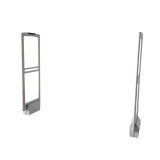Are you considering integrating RFID technology into your business operations? One essential component you’ll need to consider is RFID sensors. These sensors play a crucial role in detecting and capturing data from RFID tags, helping businesses streamline processes, improve inventory management, and enhance overall efficiency. In this ultimate buying and setup guide, we’ll explore everything you need to know about RFID sensors and provide you with valuable insights to make informed decisions. So, let’s dive in and unlock the power of RFID sensors for your business.
What are RFID sensors?
RFID sensors are devices that use radio frequency identification (RFID) technology to detect and read information from RFID tags. These tags contain data that can be wirelessly captured by the sensors, allowing businesses to track and monitor assets, products, and inventory in real-time. RFID sensors consist of a microchip, antenna, and reader, which work together to transmit and receive signals, enabling seamless data collection.
How do RFID sensors work?
RFID sensors operate using electromagnetic fields and radio waves to communicate with RFID tags. When an RFID tag comes within the proximity of an RFID sensor’s electromagnetic field, the tag’s antenna receives energy from the sensor and sends back the stored data. The RFID sensor then captures and decodes this data, enabling businesses to access valuable information such as product details, location, and movement.
Types of RFID sensors
There are various types of RFID sensors available in the market, each designed for specific applications and environments. Let’s explore some common types:
- Passive RFID sensors: These sensors rely on energy from the RFID reader to power the tag and transmit data. They are cost-effective, have a longer lifespan, and are ideal for tracking assets within a short range.
- Active RFID sensors: Active sensors have their power source and are capable of transmitting signals over longer distances. They are commonly used in applications that require real-time tracking, such as vehicle tracking and inventory management.
- Semi-passive RFID sensors: These sensors feature a battery that powers the tag’s microchip, but the data transmission is activated by an external RFID reader’s energy. They offer a balance between the longer read range of active sensors and the cost-effectiveness of passive sensors.
- UHF RFID sensors: UHF (Ultra High Frequency) sensors operate at a higher frequency range, making them suitable for applications that require long read ranges, such as supply chain management and logistics.

Benefits of using RFID sensors
Incorporating RFID sensors into your business processes can unlock a wide range of benefits. Let’s take a look at some key advantages:
- Improved efficiency: RFID sensors enable automated data capture, eliminating manual data entry and reducing human errors. This improves operational efficiency and saves time.
- Real-time tracking: With RFID sensors, businesses can track and monitor assets, inventory, and products in real-time, providing accurate and up-to-date information.
- Enhanced inventory management: RFID sensors enable inventory visibility, allowing businesses to optimize stock levels, prevent stockouts, and reduce inventory carrying costs.
- Streamlined operations: RFID sensors streamline processes such as asset tracking, supply chain management, and order fulfillment, leading to improved overall productivity and customer satisfaction.
- Increased security: RFID sensors provide enhanced security by enabling the tracking and monitoring of valuable assets, preventing theft, and improving loss prevention efforts.
Considerations when buying RFID sensors
Before purchasing RFID sensors for your business, here are some important factors to consider:
- Read range: Determine the required read range based on your specific application needs. Consider the size of the area to be covered and the distance between the RFID tags and sensors.
- Durability and environmental conditions: Assess the environmental conditions where the sensors will be deployed. Choose sensors that are suitable for the temperature, humidity, and other factors present in your operating environment.
- Integration and compatibility: Ensure that the RFID sensors you choose are compatible with your existing systems and software. Consider the integration process and any additional equipment or software required for seamless integration.
- Scalability: Consider the scalability of the RFID sensor system. Determine if you may need to expand or upgrade the system in the future and choose sensors that can accommodate future growth.
- Cost: Evaluate the total cost of ownership, including the initial investment, maintenance, and any additional fees for software or support. Balance the cost with the expected benefits and ROI.
- Support and warranty: Research the manufacturer’s reputation for customer support and inquire about warranty options and after-sales service.
By considering these factors, you can ensure that you select RFID sensors that align with your business requirements and set the stage for successful implementation.

Setting up RFID sensors
Once you have chosen the appropriate RFID sensors for your business, it’s important to follow proper setup and installation procedures. Here are some steps to guide you:
- Plan the sensor placement: Determine the optimal locations for sensor placement based on your application requirements. Consider factors such as coverage area, tag read range, and potential interference.
- Install the sensors: Follow the manufacturer’s instructions for installing the RFID sensors. Ensure proper placement, securely mount or position the sensors, and connect any necessary cables or power sources.
- Configure the reader: Set up the RFID reader to communicate with the RFID sensors. Configure the reader settings, such as read power, frequency, and data output format, according to your specific needs.
- Test and optimize: After installation, test the RFID sensor system to ensure proper functionality. Optimize the settings for optimal performance, such as adjusting the read range or sensitivity if needed.
- Integrate with software: Integrate the RFID sensor data with your existing software systems, such as inventory management or asset tracking software. Ensure proper communication and data synchronization.
- Train users: Provide training to employees or users who will be interacting with the RFID sensor system. Educate them on proper usage, troubleshooting techniques, and best practices for maximizing the benefits of RFID technology.
By following these steps, you can set up your RFID sensors effectively and maximize their impact on your business operations.
Conclusion
RFID sensors are powerful tools that enable businesses to streamline operations, improve efficiency, and enhance inventory management. By understanding the different types of RFID sensors, their benefits, and key factors to consider during the buying process, you can make informed decisions and select the right sensors for your business needs. Proper setup and integration of RFID sensors will unlock their full potential and help you unlock a world of opportunities for your business. Embrace the power of RFID technology and take your business to new heights of efficiency and success.
FAQs
1. How do RFID sensors work?
RFID stands for Radio-Frequency Identification. RFID sensors use radio waves to communicate between a reader and a tag, which contains electronically stored information. The reader sends out a signal, and when the tag is within range, it responds, transmitting data to the reader.
2. What are the main applications of RFID sensors?
RFID sensors are widely used in industries such as logistics, retail, healthcare, and manufacturing. Applications include inventory management, supply chain tracking, access control, contactless payments, and asset tracking.
3. What are the different types of RFID tags, and where are they commonly used?
RFID tags come in various forms, including passive, active, and semi-passive. Passive tags are common in supply chain and inventory management, while active tags with a built-in power source are suitable for real-time tracking and monitoring applications.
4. What security measures are in place to protect RFID systems?
To enhance security, RFID systems often use encryption and authentication protocols. Additionally, access controls, secure transmission protocols, and the implementation of privacy features on RFID tags help protect against unauthorized access and data breaches. Regular security updates and monitoring are essential for maintaining the integrity of the RFID system.


































